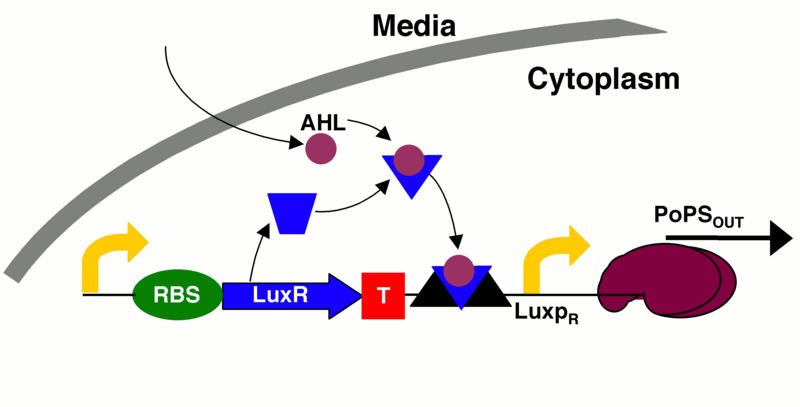Team:Cambridge/ProjectBioluminescence/Luciferase/WikiGeneticsLuxCDABE
From 2010.igem.org
Contents |
The Genetics of the Vibrio Lux operon - a short introduction
[http://www.ncbi.nlm.nih.gov/pmc/articles/PMC372803/?tool=pubmed Molecular biology of bacterial bioluminescence, Meighen, 1991] - a very complete article on the nature of bioluminescence in this system.
Operon Structure
- LuxCDABE => Emission system
- LuxRI => Regulation system (several external and intrinsic factors appear to induce and inhibit the transcription of this gene set)
- LuxO => DNA binding site for pLuxR near to:
- LuxP => lux promoter for Lux ICDABFE
The lux operon has a known gene sequence of luxCDAB(F)EG:
lux A and lux B code for the components of luciferase
lux CDE codes for a fatty acid reductase complex that makes the fatty acids necessary for the luciferase mechanism:
- Lux C codes for the enzyme acyl-reductase
- lux D codes for acyl-transferase
- lux E makes the proteins needed for the enzyme acyl-protein synthetase.
luxG codes for the reduction of FMN to FMNH2 [http://www.biomedexperts.com/Abstract.bme/18156264/LuxG_is_a_functioning_flavin_reductase_for_bacterial_luminescence (speculative) ]
luxRI codes for the quorum sensing regulatory system in fischeri, but not harveyi
- pLuxR binds to LuxO and AHL.
- LuxI is a synthase that converts SAM into AHL. This leads to a positive feedback loop that increases transcription from the right hand lux promoter.
Although the lux operon encodes the enzymes necessary for the bacteria to glow, bioluminescence is regulated by autoinduction and quorum sensing (the luxRI genes)
Mechanism
Luciferase produces blue/green light through the oxidation of reduced flavin mononucleotide (a standard biomolecule) and a long chain aldehyde by diatomic oxygen.
Reaction: FMNH2 + O2 + R-CHO ------> FMN + R-COOH + H2O + Light One photon of wavelength 490nm is emitted (Silverman et al, 1984)
In order to generate the aldehyde needed in the reaction above, three additional enzymes are needed. The fatty acids needed for the reaction are pulled out from the fatty acid biosynthesis pathway by the enzyme acyl-transferase.
Acyl-trasferase reacts with acyl-ACP (from Fatty Acid pathway) to release R-COOH, a free fatty acid.
R-COOH is reduced by a two-enzyme system to an adehyde
Reaction: R-COOH + ATP + NADPH ------> R-CHO + AMP + PPi + NADP+ (Winfrey et al, 1997).
 "
"
